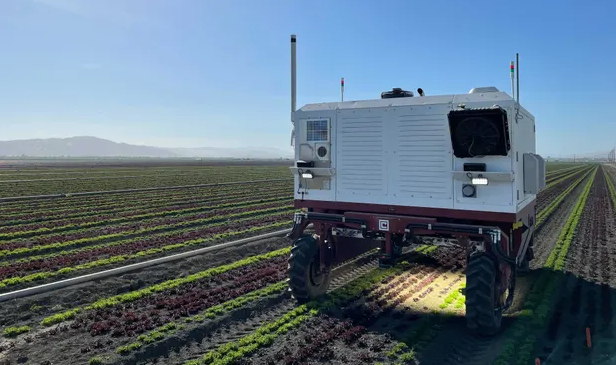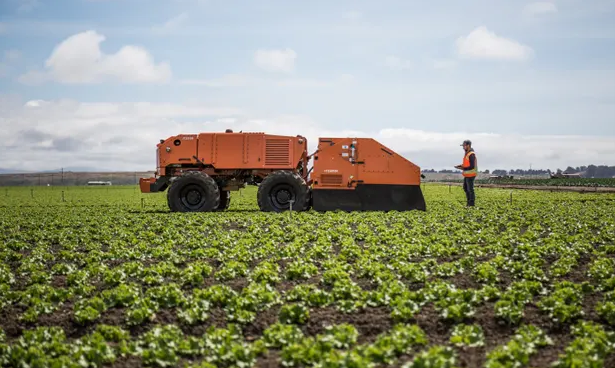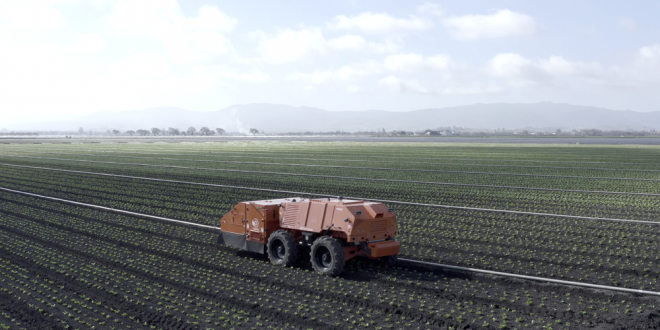The makers of robot weeders say the machines can reduce pesticide use and be part of a more sustainable food system…
In the corner of an Ohio field, a laser-armed robot inches through a sea of onions, zapping weeds as it goes.
This field doesn’t belong to a dystopian future but to Shay Myers, a third-generation farmer whose TikTok posts about farming life often go viral.
He began using two robots last year to weed his 12-hectare (30-acre) crop. The robots – which are nearly three metres long, weigh 4,300kg (9,500lb), and resemble a small car – clamber slowly across a field, scanning beneath them for weeds which they then target with laser bursts.
“For microseconds you watch these reddish color bursts. You see the weed, it lights up as the laser hits, and it’s just gone,” said Myers. “Ten years ago this was science fiction.” Other than engine sounds, the robots are almost silent and each one can destroy 100,000 weeds an hour, according to Carbon Robotics, the company that makes them.

Carbon Robotics, in common with other agri-robotic startups, emphasizes the environmental benefits these machines can bring to farming by helping to reduce soil disturbance, which can contribute to erosion, and allowing farmers to heavily reduce or even eradicate the use of herbicides.
Farmers are under increasing pressure to reduce their use of herbicides and other chemicals, which can contaminate ground and surface water, affect wildlife and non-target plants, and have been linked to increased cancer risk. At the same time, they are battling a rise in herbicide-resistant weeds, giving extra impetus to the search for new ways to kill weeds.
“Reduced herbicide usage is one of the spectacular outcomes of precision weeding,” said Gautham Das, a senior lecturer in agri-robotics at the University of Lincoln. Destroying weeds with lasers or ultraviolet light uses no chemicals at all. But even with robots that do use herbicides, their ability to precisely target weeds can reduce the use about 90% compared with conventional blanket spraying, Das said.
Five years ago there were almost no companies specializing in farm robots, said Sébastien Boyer, the French-born head of San Francisco-based robot weeding company FarmWise, but it’s now “a booming field”.
The global market for these agricultural robots – which can also be designed to perform tasks such as seeding, harvesting and environmental monitoring – is predicted to increase from $5.4bn in 2020 to more than $20bn by 2026. “Things scale up very quickly in agriculture,” said Myers.
They’re not just the preserve of larger farms, said Elizabeth Sklar, an engineering professor at King’s College London, “some of the smaller farms are able to be more flexible with trying out new approaches”.

FarmWise found its first customers in California’s Salinas Valley, which grows lettuce, broccoli, cauliflower and strawberries and is known as “America’s salad bowl”. Ten of the US’s 20 largest vegetable growers, in California and Arizona, now use the company’s robot weeders, according to Boyer. “In the beginning, they started working with us as an experiment, but now they are heavily relying on us”.
Removing pests, such as aphids, thrips and lygus bugs, is a next step for FarmWise. Robots can markedly reduce the use of fungicides and pesticides, said Boyer, by applying them more precisely, using computer vision.
As well as concerns over farming chemicals, labor shortages also play a part in robots’ advance into farmland. Farm labour can be “expensive, hard to come by and dangerous” for people involved, said Myers. In a viral TikTok video in April he said he could not hire workers to pick his asparagus crop because the government had not granted him visas in time.
Source: www.agropages.com
 THE GLOBAL WINDOW OF TURKISH FOOD AND AGRICULTURE The Global Window of Turkish Food and Agriculture Sector
THE GLOBAL WINDOW OF TURKISH FOOD AND AGRICULTURE The Global Window of Turkish Food and Agriculture Sector









